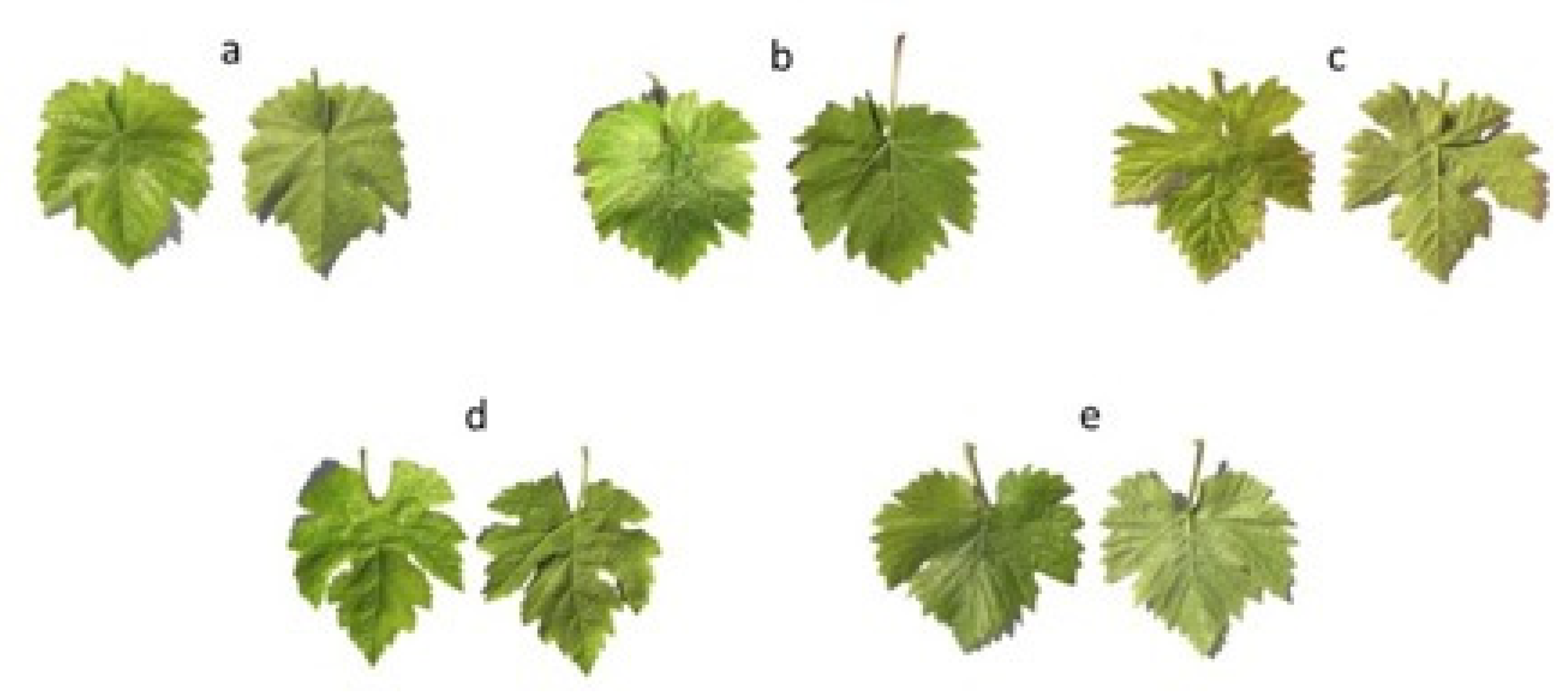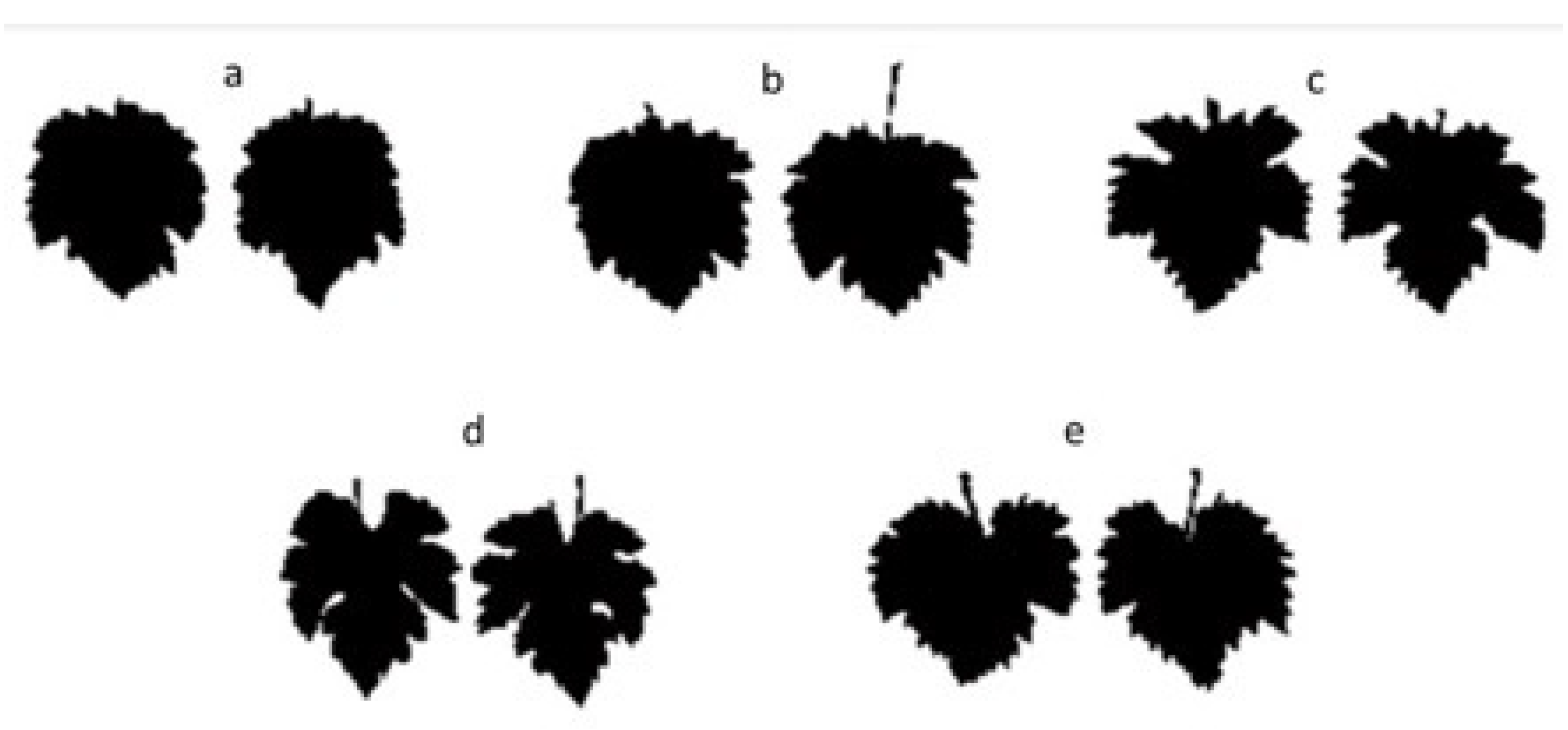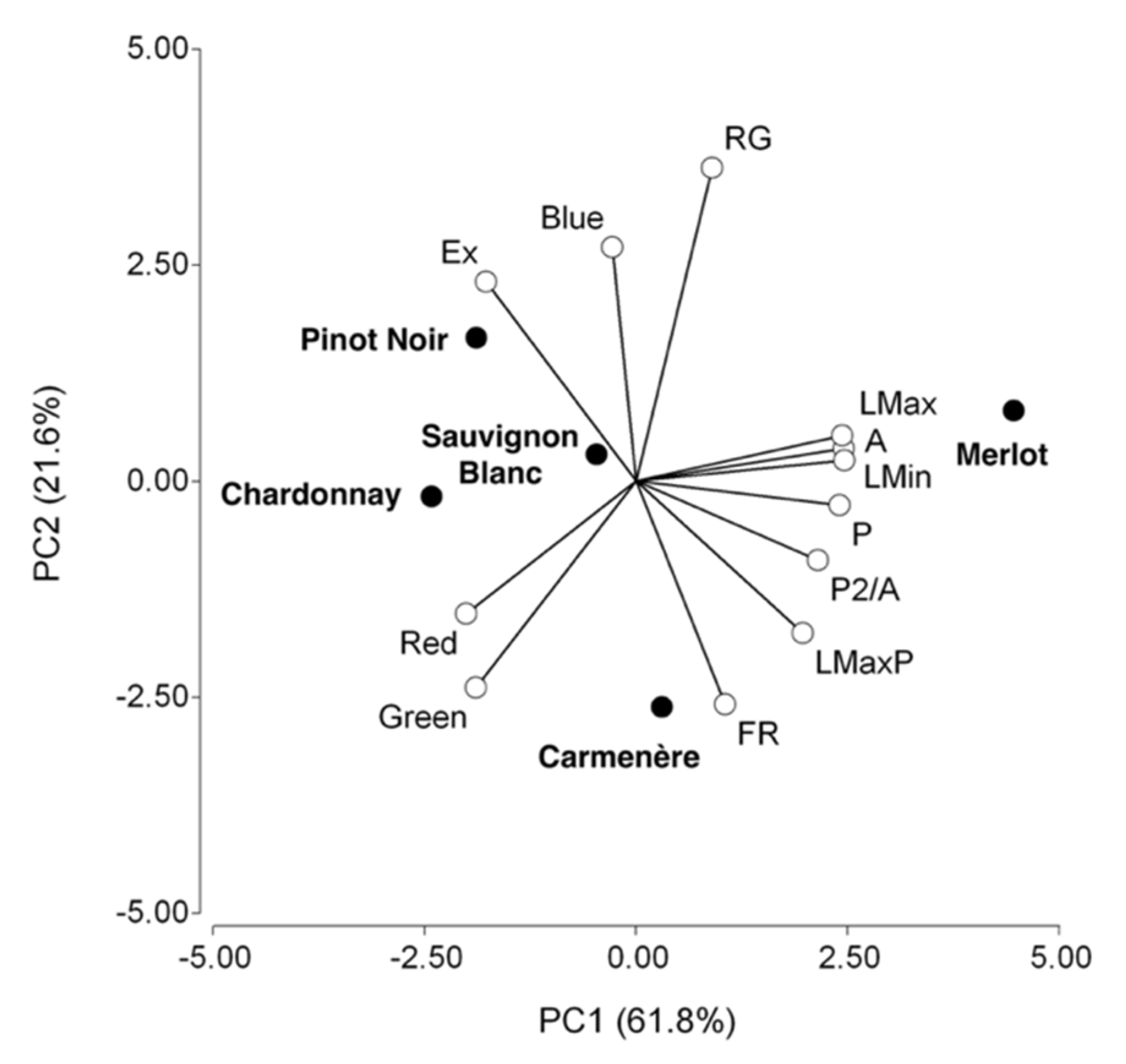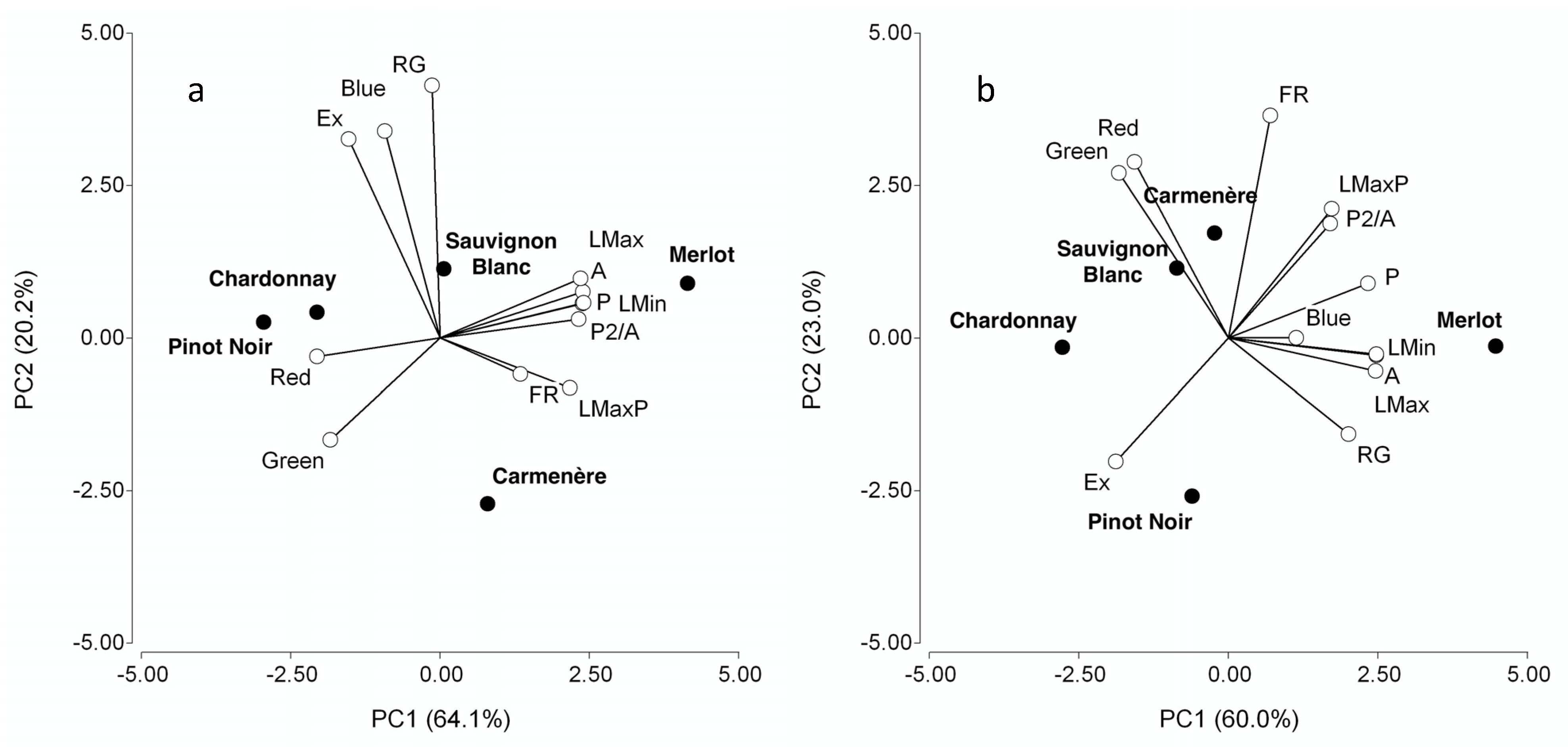Leaf Morpho-Colorimetric Characterization of Different Grapevine Varieties through Changes on Plant Water Status
Abstract
:1. Introduction
2. Materials and Methods
2.1. Site of Study and Plant Material
2.2. Soil and Climate Conditions
2.3. Experimental Design
2.4. Leaf Collection Process and Leaf Morpho-Colorimetric and Fractal Dimension Analysis
2.5. Plant Water Status and Gas Exchange Measurements
2.6. Statistical Analysis
3. Results
3.1. Leaf Morpho-Colorimetric Variables Analyzed in Grapevine Varieties Cultivated under No Water Stress Conditions
3.2. Leaf Morpho-Colorimetric Variables Analyzed in Grapevine Varieties Cultivated under Water Stress Conditions
3.3. Leaf Gas Exchange Parameters and Intrinsic Water Use Efficiency in Grapevine Varieties Managed under Different Water Supply
3.4. Multivariate Analysis to Discriminate the Different Grapevine Varieties
4. Discussion
5. Conclusions
Supplementary Materials
Author Contributions
Funding
Institutional Review Board Statement
Informed Consent Statement
Data Availability Statement
Acknowledgments
Conflicts of Interest
References
- Soldavini, C.; Schneider, A.; Stefanini, M.; Dallaserra, M.; Policarpo, M. Super ampelo, a software for ampelometric and ampelographic descriptions in vitis. Acta Hortic. 2009, 827, 253–258. [Google Scholar] [CrossRef]
- Garcia-Muñoz, S.; Muñoz-Organero, G.; De Andrés, M.T.; Cabello, F. Ampelography-An old technique with future uses: The case of minor varieties of Vitis vinifera L. from the Balearic Islands. J. Int. Des Sci. La Vigne Du Vin 2011, 45, 125–137. [Google Scholar] [CrossRef]
- Zdunić, G.; Budić-Leto, I.; Vrhovsek, U.; Tomić-Potrebuješ, I.; Maletić, E. Ampelographic and oenological characterization of the ancient grapevine cv. Dobričić grown in the coastal region of Croatia. OENO One 2012, 46, 263–273. [Google Scholar] [CrossRef]
- Barth, S.; Forneck, A.; Verzeletti, F.; Blaich, R.; Schumann, F. Genotypes and phenotypes of an ex situ Vitis vinifera ssp. sylvestris (Gmel.) beger germplasm collection from the upper rhine valley. Genet. Resour. Crop Evol. 2009, 56, 1171–1181. [Google Scholar] [CrossRef]
- Khalil, S.; Tello, J.; Hamed, F.; Forneck, A. A multivariate approach for the ampelographic discrimination of grapevine (Vitis vinifera) cultivars: Application to local Syrian genetic resources. Genet. Resour. Crop Evol. 2017, 64, 1841–1851. [Google Scholar] [CrossRef] [Green Version]
- Fuentes, S.; Hernández-Montes, E.; Escalona, J.M.; Bota, J.; Gonzalez Viejo, C.; Poblete-Echeverría, C.; Tongson, E.; Medrano, H. Automated grapevine cultivar classification based on machine learning using leaf morpho-colorimetry, fractal dimension and near-infrared spectroscopy parameters. Comput. Electron. Agric. 2018, 151, 311–318. [Google Scholar] [CrossRef]
- Tessier, C.; David, J.; This, P.; Boursiquot, J.M.; Charrier, A. Optimization of the choice of molecular markers for varietal identification in Vitis vinifera L. Theor. Appl. Genet. 1999, 98, 171–177. [Google Scholar] [CrossRef]
- Gutiérrez-Gamboa, G.; Zheng, W.; Martínez de Toda, F. Current viticultural techniques to mitigate the effects of global warming on grape and wine quality: A comprehensive review. Food Res. Int. 2021, 139, 109946. [Google Scholar] [CrossRef] [PubMed]
- Galet, P. Précis D’ampélographie Pratique, 7th ed.; Éditions, L., Ed.; Impremerie JF Impression: Montpellier, France, 1998; ISBN 2-902771-08-8. [Google Scholar]
- Bowers, J.E.; Bandman, E.B.; Meredith, C.P. DNA fingerprint characterization of some wine grape cultivars. Am. J. Enol. Vitic. 1993, 44, 266–274. [Google Scholar]
- Bodor, P.; Baranyai, L.; Ladányi, M.; Bálo, B.; Strever, A.E.; Bisztray, G.D.; Hunter, J.J. Stability of ampelometric characteristics of Vitis vinifera L. cv. “Syrah” and ‘Sauvignon blanc” leaves: Impact of within-vineyard variability and pruning method/bud load. S. Afr. J. Enol. Vitic. 2016, 34, 129–137. [Google Scholar] [CrossRef] [Green Version]
- Paňitrur-De La Fuente, C.; Valdés-Gómez, H.; Roudet, J.; Acevedo-Opazo, C.; Verdugo-Vásquez, N.; Araya-Alman, M.; Lolas, M.; Moreno, Y.; Fermaud, M. Classification of winegrape cultivars in Chile and France according to their susceptibility to Botrytis cinerea related to fruit maturity. Aust. J. Grape Wine Res. 2018, 24, 145–157. [Google Scholar] [CrossRef]
- Gutiérrez-Gamboa, G.; Pérez-Donoso, A.G.; Pou-Mir, A.; Acevedo-Opazo, C.; Valdés-Gómez, H. Hydric behaviour and gas exchange in different grapevine varieties (Vitis vinifera L.) from the Maule Valley (Chile). S. Afr. J. Enol. Vitic. 2019, 40, 181–191. [Google Scholar] [CrossRef]
- Verdugo-Vásquez, N.; Acevedo-Opazo, C.; Valdés-Gómez, H.; Ingram, B.; De Cortázar-Atauri, I.G.; Tisseyre, B. Temporal stability of within-field variability of total soluble solids of grapevine under semi-arid conditions: A first step towards a spatial model. OENO One 2018, 52, 15–30. [Google Scholar] [CrossRef] [Green Version]
- Van Leeuwen, C.; Tregoat, O.; Choné, X.; Bois, B.; Pernet, D.; Gaudillére, J.P. Vine water status is a key factor in grape ripening and vintage quality for red bordeaux wine. How can it be assessed for vineyard management purposes? OENO One 2009, 43, 121–134. [Google Scholar] [CrossRef]
- Acevedo-Opazo, C.; Valdés-Gómez, H.; Taylor, J.A.; Avalo, A.; Verdugo-Vásquez, N.; Araya, M.; Jara-Rojas, F.; Tisseyre, B. Assessment of an empirical spatial prediction model of vine water status for irrigation management in a grapevine field. Agric. Water Manag. 2013, 124, 58–68. [Google Scholar] [CrossRef]
- Jara-Rojas, F.; Ortega-Farías, S.; Valdés-Gómez, H.; Acevedo-Opazo, C. Gas exchange relations of ungrafted grapevines (cv. Carménère) growing under irrigated field conditions. S. Afr. J. Enol. Vitic. 2015, 36, 231–242. [Google Scholar] [CrossRef] [Green Version]
- Medrano, H.; Tomás, M.; Martorell, S.; Escalona, J.M.; Pou, A.; Fuentes, S.; Flexas, J.; Bota, J. Improving water use efficiency of vineyards in semi-arid regions. A review. Agron. Sustain. Dev. 2015, 35, 499–517. [Google Scholar] [CrossRef] [Green Version]
- Gutiérrez-Gamboa, G.; Liu, S.; Pszczólkowski, P. Resurgence of minority and autochthonous grapevine varieties in South America: A review of their oenological potential. J. Sci. Food Agric. 2020, 100, 465–482. [Google Scholar] [CrossRef]
- Pszczólkowski, P. Sauvignon Blanc, Cabernet-Sauvignon y Carmenère, cepas claves de la viticultura actual de Chile. RIVAR 2015, 2, 1–16. [Google Scholar]
- Pszczólkowski, P. La invención del cv. Carménère (Vitis vinifera L) en Chile, desde la mirada de uno de sus actores. Universum 2004, 19, 150–165. [Google Scholar] [CrossRef]
- Backes, A.R.; Casanova, D.; Bruno, O.M. Color texture analysis based on fractal descriptors. Pattern Recognit. 2012, 45, 1984–1992. [Google Scholar] [CrossRef]
- Uluturk, C.; Ugur, A. Recognition of leaves based on morphological features derived from two half-regions. In Proceedings of the International Symposium on INnovations in Intelligent SysTems and Applications, Trabzon, Turkey, 2–4 July 2012; pp. 1–4. [Google Scholar]
- Tassie, L. Vine Identification-Knowing What You Have; Greenhill Road Wayville: Wayville, Australia, 2010. [Google Scholar]
- Yang, F.; Liu, Q.; Cheng, Y.; Feng, L.; Wu, X.; Fan, Y.; Raza, M.A.; Wang, X.; Yong, T.; Liu, W.; et al. Low red/far-red ratio as a signal promotes carbon assimilation of soybean seedlings by increasing the photosynthetic capacity. BMC Plant Biol. 2020, 20, 148. [Google Scholar] [CrossRef] [PubMed] [Green Version]
- Tomás, M.; Medrano, H.; Escalona, J.M.; Martorell, S.; Pou, A.; Ribas-Carbó, M.; Flexas, J. Variability of water use efficiency in grapevines. Environ. Exp. Bot. 2014, 103, 148–157. [Google Scholar] [CrossRef]
- Bota, J.; Tomás, M.; Flexas, J.; Medrano, H.; Escalona, J.M. Differences among grapevine cultivars in their stomatal behavior and water use efficiency under progressive water stress. Agric. Water Manag. 2016, 164, 91–99. [Google Scholar] [CrossRef]
- Pou, A.; Medrano, H.; Tomàs, M.; Martorell, S.; Ribas-Carbó, M.; Flexas, J. Anisohydric behaviour in grapevines results in better performance under moderate water stress and recovery than isohydric behaviour. Plant Soil 2012, 359, 335–349. [Google Scholar] [CrossRef]
- Zufferey, V.; Cochard, H.; Ameglio, T.; Spring, J.L.; Viret, O. Diurnal cycles of embolism formation and repair in petioles of grapevine (Vitis vinifera cv. Chasselas). J. Exp. Bot. 2011, 62, 3885–3894. [Google Scholar] [CrossRef] [Green Version]




| Parameter | Unit | Description |
|---|---|---|
| Area (A) | cm2 | Area of the leaf surface |
| Perimeter (L) | cm | Perimeter of the leaf surface |
| Maximum length (LMax) | cm | Maximum length of the leaf |
| Minimum length (LMin) | cm | Minimum length of the leaf |
| Maximum length of petiole (LMax P) | cm | Length of leaf vine petiole |
| Area to perimeter ratio (P2/A) | Unitless | Area to perimeter ratio of leaf |
| Eccentricity (Ex) | Unitless | Length: width ratio in which zero is given to a straight line and one represents a circle |
| RGB color scale | Unitless | RGB scale used to measure color: R = red, G = green, B = blue colors and RG = red and green index |
| Fractal dimension (FR) | Unitless | Fractal dimension measured using the box-counting method |
| Parameter | Treatment | Variety | ||||
|---|---|---|---|---|---|---|
| Carmenère | Chardonnay | Merlot | Pinot Noir | Sauvignon Blanc | ||
| Area (cm2) | No Stress | 161.37 ± 18.55 ab | 137.08 ± 6.58 a | 196.05 ± 14.85 b | 160.87 ± 5.71 ab | 152.22 ± 15.67 a |
| Stress | 143.92 ± 10.14 a | 129.74 ± 2.38 a | 180.87 ± 18.62 b | 121.15 ± 18.29 a | 147.21 ± 0.68 ab | |
| Perimeter (cm) | No Stress | 83.01 ± 6.10 a | 75.77 ± 2.30 a | 98.17 ± 4.23 b | 74.57 ± 1.78 a | 77.28 ± 3.70 a |
| Stress | 80.29 ± 3.11 a | 74.67 ± 1.09 a | 97.80 ± 9.54 b | 67.12 ± 5.55 a | 79.65 ± 3.22 a | |
| Maximum length (cm) | No Stress | 13.10 ± 0.74 a | 12.36 ± 0.24 a | 14.62 ± 0.46 b | 13.20 ± 0.28 a | 12.73 ± 0.71 a |
| Stress | 12.43 ± 0.44 a | 12.09 ± 0.06 a | 14.09 ± 0.71 b | 11.53 ± 0.91 a | 12.64 ± 0.42 ab | |
| Minimum length (cm) | No Stress | 12.30 ± 0.76 a | 11.31 ± 0.32 a | 13.76 ± 0.60 b | 12.24 ± 0.24 a | 11.86 ± 0.57 a |
| Stress | 11.62 ± 0.38 a | 11.01 ± 0.13 a | 13.08 ± 0.68 b | 10.55 ± 0.79 a | 11.64 ± 0.37 a | |
| Maximum length of petiole (cm) | No Stress | 11.78 ± 1.01 b | 9.00 ± 0.29 a | 11.80 ± 0.85 b | 10.12 ± 0.66 ab | 11.40 ± 1.25 b |
| Stress | 10.76 ± 0.43 b | 9.01 ± 0.23 ab | 11.05 ± 0.64 b | 7.93 ± 1.18 a | 10.45 ± 0.94 b | |
| Area to perimeter ratio | No Stress | 42.76 ± 1.40 b | 41.89 ± 0.67 b | 49.23 ± 2.44 c | 34.57 ± 0.66 a | 39.32 ± 0.50 b |
| Stress | 44.88 ± 2.59 a | 42.98 ± 0.54 a | 52.90 ± 4.98 b | 37.33 ± 0.51 a | 43.19 ± 3.07 a | |
| Eccentricity | No Stress | 0.35 ± 0.01 a | 0.41 ± 0.00 a | 0.35 ± 0.04 a | 0.39 ± 0.03 a | 0.37 ± 0.03 a |
| Stress | 0.35 ± 0.01 a | 0.42 ± 0.02 b | 0.38 ± 0.02 ab | 0.41 ± 0.03 b | 0.40 ± 0.00 ab | |
| Red color | No Stress | 69.48 ± 2.28 c | 68.96 ± 0.63 bc | 63.58 ± 2.35 a | 64.37 ± 0.95 ab | 71.83 ± 1.80 c |
| Stress | 74.93 ± 2.50 b | 81.24 ± 2.49 b | 68.16 ± 1.09 a | 75.92 ± 3.47 b | 75.94 ± 2.44 b | |
| Green color | No Stress | 75.06 ± 3.05 c | 74.35 ± 1.73 bc | 65.39 ± 3.39 a | 67.72 ± 1.82 ab | 75.74 ± 1.96 c |
| Stress | 81.48 ± 2.74 bc | 85.36 ± 2.55 c | 70.91 ± 0.71 a | 78.97 ± 3.58 bc | 77.77 ± 1.72 b | |
| Blue color | No Stress | 46.54 ± 0.76 a | 46.86 ± 1.69 a | 48.53 ± 0.62 a | 47.53 ± 1.52 a | 49.06 ± 0.49 a |
| Stress | 45.78 ± 0.63 a | 50.34 ± 0.83 b | 47.81 ± 1.52 ab | 48.04 ± 1.40 ab | 49.49 ± 1.10 b | |
| Fractal dimension | No Stress | 1.65 ± 0.02 a | 1.52 ± 0.02 a | 1.64 ± 0.04 a | 1.65 ± 0.02 a | 1.60 ± 0.03 a |
| Stress | 1.67 ± 0.02 a | 1.67 ± 0.01 a | 1.63 ± 0.03 a | 1.49 ± 0.03 a | 1.64 ± 0.01 a | |
| Red and green index | No Stress | −0.039 ± 0.005 a | −0.037 ± 0.007 a | −0.014 ± 0.009 b | −0.025 ± 0.009 ab | −0.027 ± 0.005 ab |
| Stress | −0.042 ± 0.010 a | −0.025 ± 0.004 ab | −0.020 ± 0.010 b | −0.020 ± 0.006 b | −0.012 ± 0.005 b | |
| Parameter | Treatment | Variety | |||
|---|---|---|---|---|---|
| Chardonnay | Merlot | Pinot Noir | Sauvignon Blanc | ||
| Net CO2 assimilation (AN) | No stress | 16.74 a | 16.36 a | 16.39 a | 17.39 a |
| Stress | 10.90 a | 11.04 a | 10.33 a | 13.30 a | |
| Both | 13.82 a | 13.70 a | 13.36 a | 15.35 a | |
| Transpiration (E) | No stress | 11.01 ab | 11.81 b | 9.47 a | 12.23 b |
| Stress | 7.49 a | 7.37 a | 6.45 a | 7.79 a | |
| Both | 9.25 a | 9.59 a | 7.97 a | 10.00 a | |
| Stomatal conductance (gs) | No stress | 0.42 ab | 0.40 a | 0.38 a | 0.54 b |
| Stress | 0.25 a | 0.22 a | 0.20 a | 0.30 a | |
| Both | 0.33 a | 0.31 a | 0.34 a | 0.42 a | |
| Intrinsic water-use efficiency (AN gs−1) | No stress | 40.30 ab | 41.24 b | 48.06 b | 32.40 a |
| Stress | 68.02 a | 70.95 a | 65.69 a | 67.89 a | |
| Both | 50.14 a | 56.09 a | 56.87 a | 50.14 a | |
Publisher’s Note: MDPI stays neutral with regard to jurisdictional claims in published maps and institutional affiliations. |
© 2021 by the authors. Licensee MDPI, Basel, Switzerland. This article is an open access article distributed under the terms and conditions of the Creative Commons Attribution (CC BY) license (https://creativecommons.org/licenses/by/4.0/).
Share and Cite
Gutiérrez-Gamboa, G.; Torres-Huerta, N.; Araya-Alman, M.; Verdugo-Vásquez, N.; Moreno-Simunovic, Y.; Valdés-Gómez, H.; Acevedo-Opazo, C. Leaf Morpho-Colorimetric Characterization of Different Grapevine Varieties through Changes on Plant Water Status. Horticulturae 2021, 7, 315. https://doi.org/10.3390/horticulturae7090315
Gutiérrez-Gamboa G, Torres-Huerta N, Araya-Alman M, Verdugo-Vásquez N, Moreno-Simunovic Y, Valdés-Gómez H, Acevedo-Opazo C. Leaf Morpho-Colorimetric Characterization of Different Grapevine Varieties through Changes on Plant Water Status. Horticulturae. 2021; 7(9):315. https://doi.org/10.3390/horticulturae7090315
Chicago/Turabian StyleGutiérrez-Gamboa, Gastón, Nicolás Torres-Huerta, Miguel Araya-Alman, Nicolás Verdugo-Vásquez, Yerko Moreno-Simunovic, Héctor Valdés-Gómez, and César Acevedo-Opazo. 2021. "Leaf Morpho-Colorimetric Characterization of Different Grapevine Varieties through Changes on Plant Water Status" Horticulturae 7, no. 9: 315. https://doi.org/10.3390/horticulturae7090315
APA StyleGutiérrez-Gamboa, G., Torres-Huerta, N., Araya-Alman, M., Verdugo-Vásquez, N., Moreno-Simunovic, Y., Valdés-Gómez, H., & Acevedo-Opazo, C. (2021). Leaf Morpho-Colorimetric Characterization of Different Grapevine Varieties through Changes on Plant Water Status. Horticulturae, 7(9), 315. https://doi.org/10.3390/horticulturae7090315









